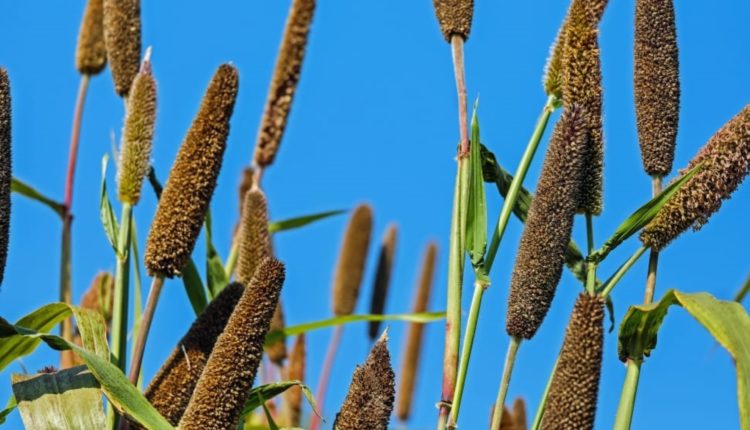Climate-smart cereal – a boon to farmers
Millets are coarse cereals gaining popularity because of their nutritional benefits. However, the demand for millets remains low due to the predominant consumption of rice and wheat in India. An important crop of the arid and semi-arid regions of Asia and Africa, it assists in food security. States growing millets in India include Uttar Pradesh, Punjab, Andhra Pradesh, Tamil Nadu, Rajasthan, Maharashtra, and Gujarat. Millets are exciting because they can grow in poor soil conditions with less water, fertilizer, and pesticides. They can withstand higher temperatures, making them the perfect choice as ‘climate-smart’ cereals.
The productivity of various types including foxtail millet, finger millet, pearl millet, and sorghum in drylands, has doubled in the past 40 years due to the adoption of hybrid varieties and enhanced farming technology. According to research, more than 80 hybrids of millets are currently available in the Indian market.
Millets help to improve the food security status
Millets are a rich source of essential amino acids, soluble and insoluble dietary fiber, proteins, vitamins, iron, calcium, magnesium, potassium, phosphorous, and vital vitamins. Millets, as compared to other cereals, are not spoiled easily during storage. Some millets have a shelf life of 10 to 12 years. Thus, in addition to their nutritional and functional properties, millets help in creating food security.
The inter-cropping of millets with pulses also improves food security. For example, millets have a crop duration of 80 to 90 days, which is half the duration of pigeon pea. By the time millets are harvested, the pigeon pea crop is well-rooted and established. Both crop diversification and inter-cropping assist in improving rural household food security status.
Production of millets in India


Source: Directorate of Millets Development, Department of Agriculture, Cooperation and Farmer’s Welfare

The above graphs suggest that the total millet production in India reached 17.8 million tons in 2018. Despite the decline in production of overall millets in past years till 2016, production has increased significantly during 2016-2018 due to the application of improved varieties. However, the area under millet crop decreased by 8.85% during 2013-2017. Millets production grew by 9.65% in 2016-17 and 9.76% during 2017-18 owing to growing demand in urban cities. Various studies have shown that the overall sales of millets have increased four to five times in the past one and a half years.
Browntop millet
Of all the varieties of millets, Browntop millet (Urochloa ramose), also known as Korale millet, is witnessing a huge demand in the Indian market owing to its nutritional content and ability to adapt to climate change. Browntop millet apart from being gluten-free is rich in protein content, fiber, and minerals. It also assists in lowering glycemic response (lower ability to increase blood sugar level), lower digestibility, and absorption of starch.
Nevertheless, the consumption of Browntop millet in India is niche and accounts for less than 0.1% of the total millet market. However, the average price of Browntop Millet is Rs 290 for one kilogram, while the cost of other millets is approximately Rs 80 to 90 for one kilogram. The low scale of production of Browtop millet has resulted in its increased price compared to other millets. Native to Karnataka, the demand of Browntop millet is increasing in other states as well.
A healthy alternative to other cereals
Rice a common mid-day meal provided to school children can easily be substituted by Browntop millet with similar cooking time. In addition, it has comparatively less carbohydrates and is low in its glycemic index (GI) as compared to rice. Browntop millet is tasty when combined with sweet ingredients such as jaggery for making traditional sweets. The application of Browntop millet is at present limited to sweets, but it can be used for healthy snacks, snack bars, ready to eat products, and breakfast cereals. Several regional foodservice restaurants and hotels have also started incorporating these millets in their menus.
Various conventional food technologies that are applicable for value-added products of Browntop millet including explosive or gun puffing, hot and cold extrusion, mixing, and baking. Instant mixes in powder form are also being produced. In general, other millets-based products are limited to sweet and savory snacks, ready to eat, and breakfast cereals only.
Nutritionists suggest Browntop millet as a solution to prevalent lifestyle problems such as diabetes, arthritis, and heart disease. However, it is yet to gain popularity due to a lack of consumer awareness, and disinterest among food processing companies. Browntop millet has a great scope for consumption growth. Farmer can benefit from its low input and maintenance requirements, and hence low risk.
Author: Saujanya Suman – consultant at Sathguru Management Consultants in food processing domain
First Published in: IndifoodBev

